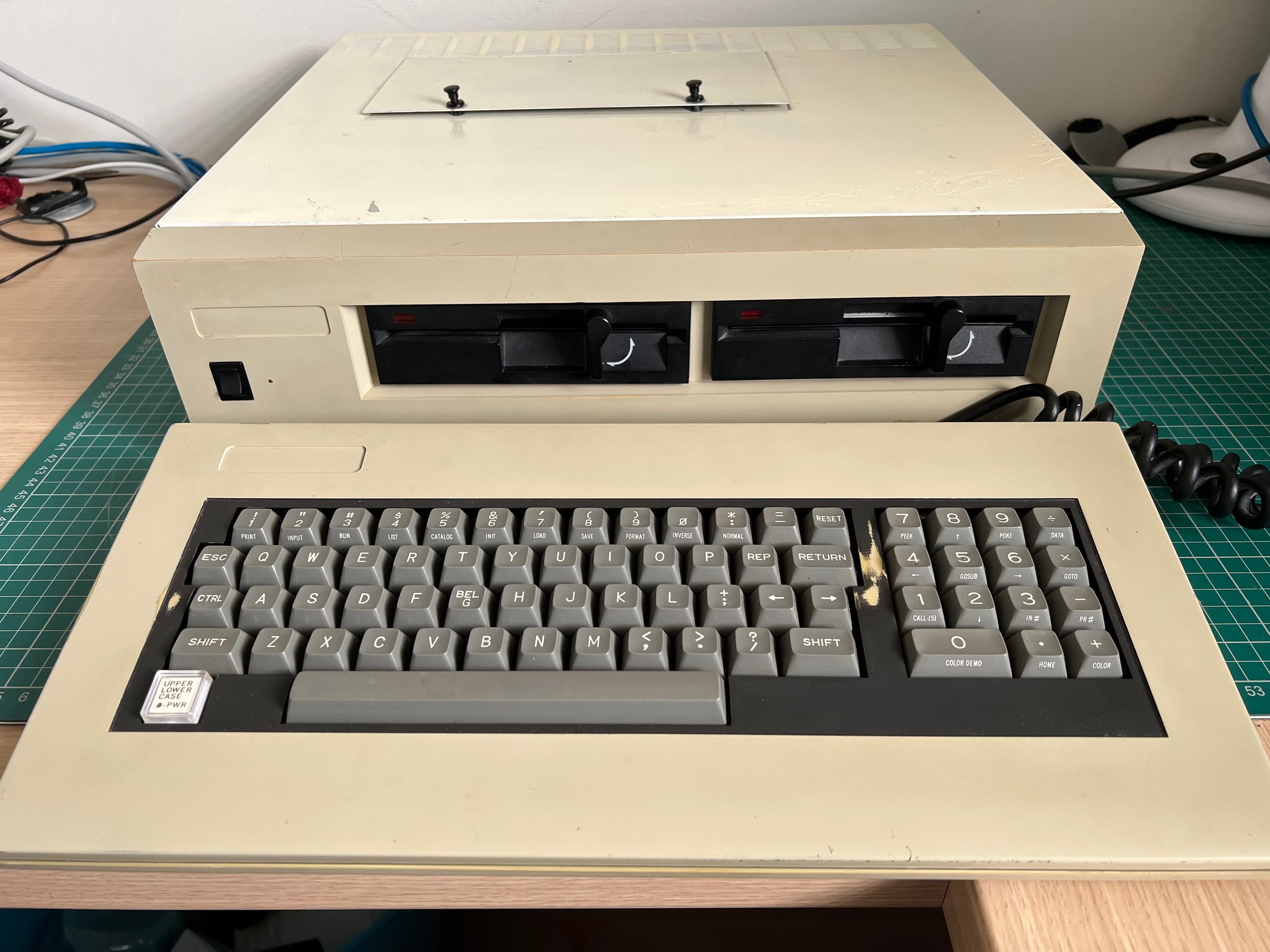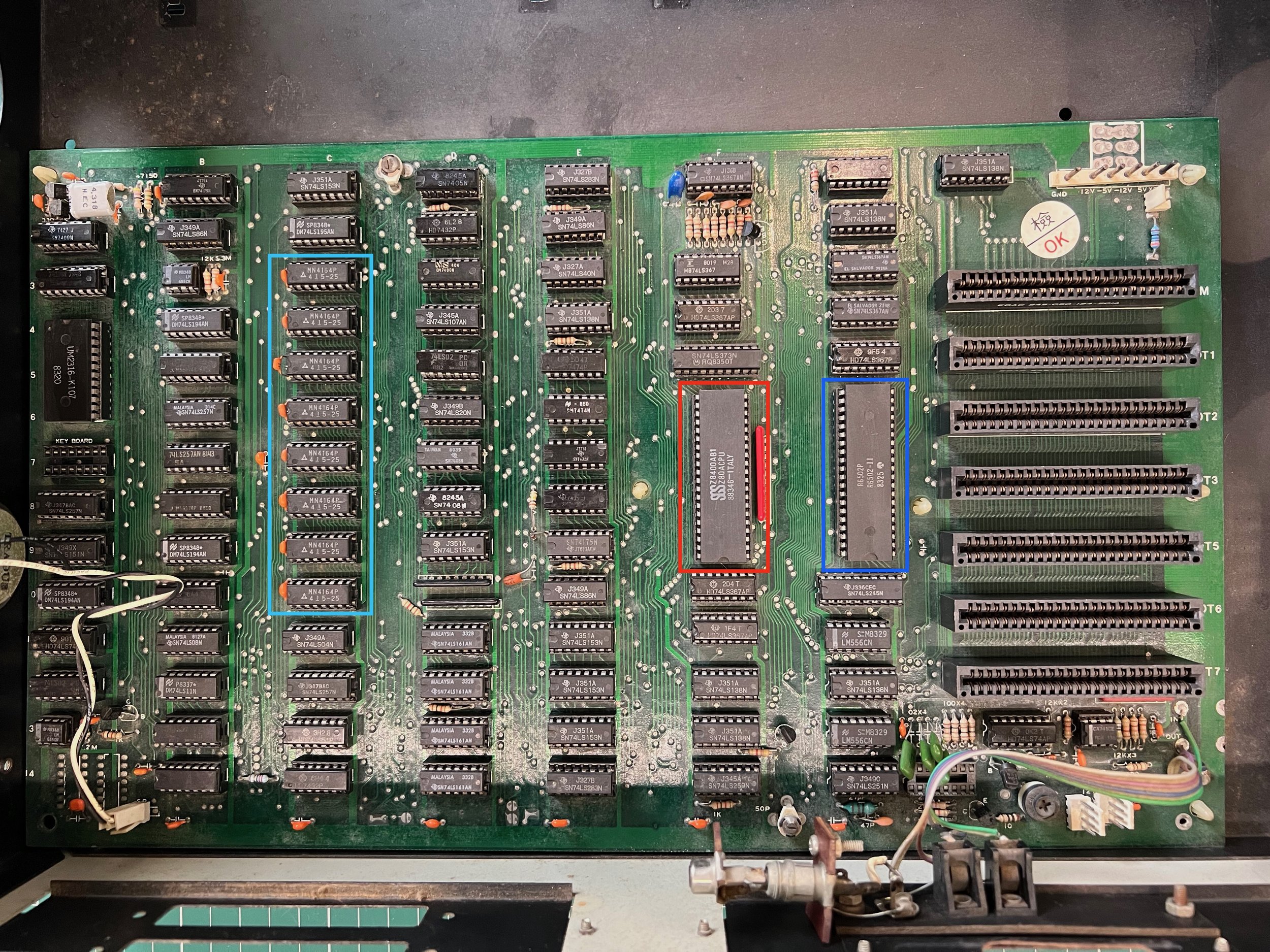A mysterious home made Aussie Apple ][ clone?
I sourced this clone from good friend Alex Bons. I love it for its unique detachable keyboard and XT style case. The form factor of this case isn’t unique but rarer than your usual everyday clone which makes use of an Apple ][ style case. What is unusual are the modifications made to the case. Everything about this case screams homemade. From the external keyboard cable simply sticking out of the bottom of the front bezel to the internal power switch plus lack of any branding, serial numbers or manufacture markings makes me think with was the work of an 1970’s “home-brew” hacker. Given the power supply is 240v only makes me think it is also the work of an Australian hacker.
As I always do I simply plugged it in, put a DOS 3.3 Master disc in the drive and turned it on. To my surprise it actually booted. Displaying on the top middle of the screen was “APCOM ][“ rather than an “Apple ][“, totally expected behaviour given it was clearly a clone. Next task was to identify what I was actually dealing with. For this I always use MECC Computer Inspector. I have found it good for checking the basics, in this case an Apple II+ with 64K of RAM and a Disk ][ controller in slot 6. The “unknown” in slot 3,5 and 7 are still a mystery as subsequent investigations showed that slots 5 and 7 were empty, slot 3 had a card in it as did slot 4 sort of. (more on that later).
Next it was time for some hardware identification. After opening the little hatch on the top I was able to see that it indeed it had a clone Apple ][ Disk Controller card in slot 6 but couldn’t really see anything else. The hatch was clearly designed to be as small as possible yet still allow for the installation and removal of cards. I imagine it would required a lot of twisting and jiggling to fit full length cards in.
Even with a limited view of the innards I could see seven Apple ][ expansion slots labeled ROM, Slot 1, Slot 2, Slot 3, Slot 5, Slot 6, Slot 7. Notice no Slot 4 (I will get to why later). I could also see a small card in the slot labelled “ROM” where Slot 0 slot would be on a genuine Apple ][+ motherboard. Being the sleuth I am I figured this would be the ROM card that most clones had rather than socketed on the board. I have heard that this was possibly an attempt by the clone manufacturers to avoid legal issues with Apple. The Disk Smith CAT (rebadge Laser 3000 in Australia) took a similar approach with its “Compatibility” cartridge. The vendor was able to sell the base unit without the cartridge and it would function but it wouldn’t be Apple ][ compatible. They could then sell the cartridge as a seperate item and once plugged into the CAT would give it Apple ][ compatibility. I am hoping to cover the CAT in some detail in a future post. In slot 6 was as expected an Apple ][ disk controller clone. Slot 3 appears to be an 80 column card clone which would require more investigation.
Time to have a better look inside. Clones are notorious for their unfriendliness when it came to opening and dismantling. I know a little bit about industrial design and a key part of the design is how easy it is to service. This design principle has been lost in the modern disposable consumer electronics era where size and cost outlays serviceability. With only four screws to remove to get the top case off I thought the long forgotten industrial designer of this case was following a path to serviceability. After removing the top cover I discovered that that designer must have had the day off when designing this case. As an example, to remove the power supply I needed to remove the left floppy drive. To remove the drive I needed to remove the substructure that held the two TEAC FD55A 5.25” drives. There were two drive carries, two support rails and a total of 12 screws on top and 8 screws underneath. Every screw was a different length and diameter. To be fair the different screws could be from 30 years of previous owners tinkering.
After a hazardous tear down included the usual sharp edge finger cuts and knuckle scrapes I finally had the whole board exposed. At first glance a few suspicions were confirmed. Firstly it definitely had 64KB of RAM (light blue on the photo below) as per MECC Computer Inspector. And secondly it has a Z80 co-processor (Red in photo below), so that clears up the missing Slot 4 mystery. Third party Z80 CPM cards usually go in Slot 4 so this one has the card built in. After a bit of googling (Duck Duck Go actually) I think I had finally identified the board. It was a GTAC Type 2 motherboard. GTAC = Generic Taiwanese Apple Clone. Basically a generic design that was used by many manufacturers. Type 2 meant that it had 64KB of RAM and a Z80 card builtin as opposed to the Type one which had 48KB of RAM and no Z80.
http://john.ccac.rwth-aachen.de:8000/patrick/MEWA48.htm
https://mirrors.apple2.org.za/ground.icaen.uiowa.edu/MiscInfo/Misc/clones
Now that the motherboard had been identified it was time for the power supply. It is clearly marked as a Seasonic Model 462. I was surprised to find that Seasonic are still in business and still selling PSU for home hobbyists. My suspicion that this clone has been tinkered with (to my advantage I might add) was confirmed when I opened the PSU. All the potentially problematic capacitors had all been replaced. On much closer inspection it appears that this PSU had suffered a catastrophic failure at some point given the scorch marks and residue on the PCB. My other suspicion that this was probably a home made clone was getting clearer as the PSU didn’t match the external computer case in any way. The cutout in the backplane did not line up with the switch on the PSU. This home builder improvised by moving the PSU further inside the case and threaded the power cable through the hole in the backplane that would have had a switch fixed to it. To switch on the computer you either need to use the power point or stick you finger about 50mm inside the case and use the switch on the back of the PSU. Another indication of the homemade job was the front switch that does nothing, it is connected to nothing and has very small gauge wire that weren’t be sensible to use with 240v.
I now had a refurbished PSU, a working GTAC-2 motherboard, a working disk controller card and working disk drives. It was time to look at that card in slot 3. As I suspected it was a functioning 80 column card with a very interesting internal connector set up which allowed the 80 column mode to display via the external RCA connector on the case without unplugging the monitor’s RCA connector. Many clone 80 column cards do this but usually it is a matter of threading the RCA cable through the back of the case and attaching it directly to the card.
One of the things that makes this clone so unique is the seperate keyboard. It has a very nice feel to it, has Upper and Lowercase as well as a whole heap of macros printed on the keys and activated by the CTRL key. The keyboard cable has the usual 8 pin motherboard header that genuine Apple II motherboards have however this cable then threads its way out of the case to a DB-15 female connector that plugs into the keyboard. The homebrew nature of this clone shows itself here also as the cable exits the case really awquardly via a cutout in the front plastic bezel. Whilst photographing the keyboard I noticed a name engraved in the back of the keyboard with a number - McKern NSW CO9810.
After spending a bit of quality time with this clone I am convinced that this was a homebrew computer. The power supply that didn’t fit, the switch on the front that wasn’t connected and the hole in the front bezel for the keyboard cable all pointed to this conclusion. The final evidence for me was lying in plain sight the whole time. When I looked straight on to the side of the case it was clearly a home aerosol spray can paint job. There was no other paint under this so the case was clearly supplied new unpainted. I could not imagine a commercial computer product no matter how small a batch shipping out the door unpainted. Was Mr/Mrs/Miss McKern of New South Wales, Australia the builder of this mysterious clone? I hope so as it makes this clone a very cool piece of Australian computer history.
![A mysterious home made Aussie Apple ][ clone?](https://images.squarespace-cdn.com/content/v1/5900136586e6c0c3e9f69eab/1642555781784-3J6X7MCKFDTTMQ5862R1/IMG_0169.jpeg)


































